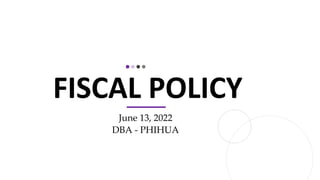The document discusses fiscal policy, defining it as government manipulation of expenditures and taxes to influence economic activity. It explains concepts such as potential GDP, budget deficits, and the business cycle phases while highlighting the importance of fiscal and monetary policies in managing economic growth and stability. Additionally, it outlines principles for effective monetary policy and the transmission mechanism of such policies on economic activity and inflation.





























